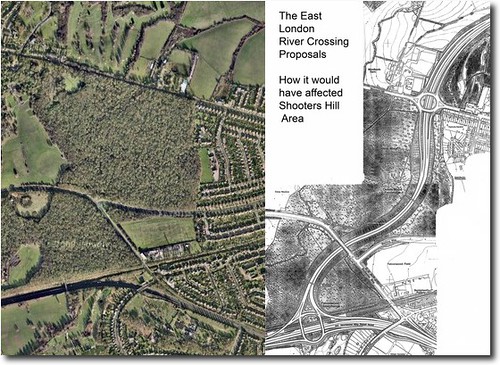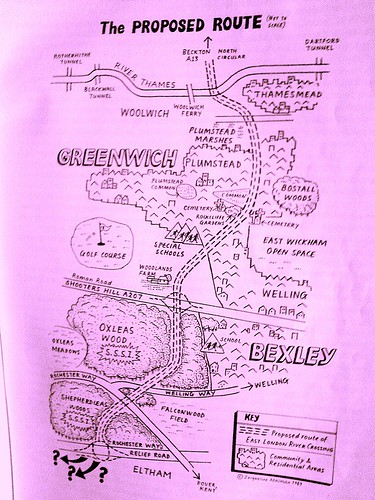
Is Shooters Hill still safe from Ringway 2?
On Tuesday June the 30th I was on the way to work and saw a police biker at the roadside pulling over drivers so they could be interviewed by traffic surveyors modelling journeys on behalf of tfl.
According to the researchers, this particular survey is a routine exercise, and will provide London’s traffic managers with an insight into the toing and froing in this area. This sounds plausible and even sensible, however, it also transpired that similar ‘routine’ inspections are being carried out in east london. Perhaps I was wrong to infer the link, but the utterance of the words east london, south east london, and traffic modelling in one sentence immediately made me think of Ringway 2…
Traffic designs linking the south/north twistulars completing an inner london ring road go back at least as far as the now infamous Ringway 2 blueprint of the 1960’s, and they seem here to stay, in design form at least. These plans were succesfully blocked by the people of south east london in 1973, 1993 and 2008. Things looked especially bad for Shooters Hill in the early nineties, but the area did ultimately fare better than Wanstead and Twyford Down…
On past form at least, Shooters Hill does appear to be safe from the bulldozers for at least another ten years. However the surrounding area may not be, as attention has now shifted to Blackwall. Clive Efford is currently lobbying for a third blackwall crossing, which would include a doglands light rollercoaster to north greenwich and onwards to eltham. His campaign has its merits, primarily it doesn’t have ill intentions for the woods, secondly it makes use of pre-existing links to the south/north twistulars and A2 (which was the original justification for the oxleas woods bypass linking the A2 at falconwood to the crossing at woolwich), and thirdly, the inclusion of a public transport link is a very smart idea as it improves the image of what is, first and foremost, a road building scheme. There are probably some potential traffic problems to be worked out however, and this will be done with traffic modelling!!
If the link at Blackwall gets improved, will it attract more traffic? Will the approach roads and residential areas on each side be able to accomodate extra through traffic?… Furthermore, Blackwall has never had a particularly good record on pollution, air quality measurements at woolwich flyover routinely fail to meet the air quality objectives, what will the building of new roads do for air quality? (Actually for balance it should be added that most of London fails to meet its pollution targets – not that that makes it alright for blackwall to be as bad as it is).
On that note, here’s the survey debrief:
TRANSPORT FOR LONDON: ROADSIDE INTERVIEW SURVEYS
This survey has been commissioned by Transport for London (TfL). Colin Buchanan is conducting it at this site on their behalf.
In order to address transport problems, we need to know more about current travel patterns and so are conducting the survey. It is taking place at a range of locations across the study area. It will last only one day at each location. Stopping vehicles in this way is the only effective way of establishing the volume and types of journeys being made on a typical day.
Thank you for taking the time to provide TfL with this important information.
We would like to apologise for any inconvenience caused by the survey. Every effort has been made to minimise disruption and congestion, but it is not always possible to achieve this as successfully as we would like.
The data you provide will only be used for transport planning purposes by TfL, its agents, London Boroughs and other agencies involved in transport planning.
Should you require any further information about the survey please contact us using the details below. Phones are not continuously manned, but calls will be returned within 24 hours.
Transport for London
T: 02071261423 E: travelresearch@tfl.gov.uk
Colin Buchanan
E: surveys@cbuchanan.co.uk
Three days ago I emailed the supplied contact details to enquire about the motivations for this survey, if I hear back, I will comment further…







